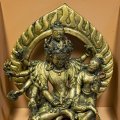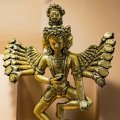Patan Museum (Nepal): photo 58
Photo 58 of 212 in Gallery: Patan Museum (Nepal)

Image title: Eleven-headed Avalokiteshvara (from Tibet)
Description of the photo
This Bronze sculpture shows an image of Eleven-headed Avalokiteshvara, from the 17th century origination from Tibet.—Materials used: Bronze.
Description: Here the multiple heads graphically illustrate both a myth and an aspect. Myth asserts that Avalokiteshvara’s intense compassion for humanity shattered his skull. His spiritual father, Amitabha, replaced it with ten others, crowning them with his own. Actually, the eleven heads correspond to compass points under the deity’s beneficent watch.
Notes: Why do gods have multiple heads and hands? In the later development of Hindu and Buddhist practice, known as Tantrism or, in Vajrayana Buddhism, “The Way of the Thunderbolt”, deities are given multiple heads and limbs to better express their complex personalities and their multiple functions.
Gallery information:
The Patan Museum is located on the Durbar square of Patan (Lalitpur/Lalitapura, Kathmandu, Nepal) which is associated Keshav Narayan Chowk (Keshavnarayan)—a form of Lord Vishnu. Being listed as a World Heritage Site, the whole of Durbar square is filled with exquisite temples, sculptures and other ancient structures, of which the ancient history history can be traced to the Malla Kings of Lalitpur. It is an important site for both Buddhism and Hinduism.
Photo details:
Date: 2019-12-02
Camera: SONY ILCE-6400
Exposure: 1/25
Aperture: f/4.5
ISO: 100
Focal length: 30mm
High resolution:
Download file
Size: 4.08 MB
Resolution: 2268 x 3504
© Photograph by Gabe Hiemstra.
License: CC BY-NC-ND 4.0

